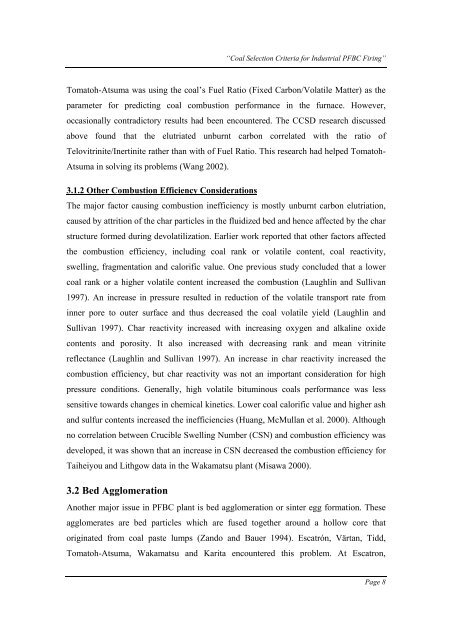coal selection criteria for industrial pfbc firing project 3.2 - CCSD
coal selection criteria for industrial pfbc firing project 3.2 - CCSD
coal selection criteria for industrial pfbc firing project 3.2 - CCSD
You also want an ePaper? Increase the reach of your titles
YUMPU automatically turns print PDFs into web optimized ePapers that Google loves.
“Coal Selection Criteria <strong>for</strong> Industrial PFBC Firing”<br />
Tomatoh-Atsuma was using the <strong>coal</strong>’s Fuel Ratio (Fixed Carbon/Volatile Matter) as the<br />
parameter <strong>for</strong> predicting <strong>coal</strong> combustion per<strong>for</strong>mance in the furnace. However,<br />
occasionally contradictory results had been encountered. The <strong>CCSD</strong> research discussed<br />
above found that the elutriated unburnt carbon correlated with the ratio of<br />
Telovitrinite/Inertinite rather than with of Fuel Ratio. This research had helped Tomatoh-<br />
Atsuma in solving its problems (Wang 2002).<br />
3.1.2 Other Combustion Efficiency Considerations<br />
The major factor causing combustion inefficiency is mostly unburnt carbon elutriation,<br />
caused by attrition of the char particles in the fluidized bed and hence affected by the char<br />
structure <strong>for</strong>med during devolatilization. Earlier work reported that other factors affected<br />
the combustion efficiency, including <strong>coal</strong> rank or volatile content, <strong>coal</strong> reactivity,<br />
swelling, fragmentation and calorific value. One previous study concluded that a lower<br />
<strong>coal</strong> rank or a higher volatile content increased the combustion (Laughlin and Sullivan<br />
1997). An increase in pressure resulted in reduction of the volatile transport rate from<br />
inner pore to outer surface and thus decreased the <strong>coal</strong> volatile yield (Laughlin and<br />
Sullivan 1997). Char reactivity increased with increasing oxygen and alkaline oxide<br />
contents and porosity. It also increased with decreasing rank and mean vitrinite<br />
reflectance (Laughlin and Sullivan 1997). An increase in char reactivity increased the<br />
combustion efficiency, but char reactivity was not an important consideration <strong>for</strong> high<br />
pressure conditions. Generally, high volatile bituminous <strong>coal</strong>s per<strong>for</strong>mance was less<br />
sensitive towards changes in chemical kinetics. Lower <strong>coal</strong> calorific value and higher ash<br />
and sulfur contents increased the inefficiencies (Huang, McMullan et al. 2000). Although<br />
no correlation between Crucible Swelling Number (CSN) and combustion efficiency was<br />
developed, it was shown that an increase in CSN decreased the combustion efficiency <strong>for</strong><br />
Taiheiyou and Lithgow data in the Wakamatsu plant (Misawa 2000).<br />
<strong>3.2</strong> Bed Agglomeration<br />
Another major issue in PFBC plant is bed agglomeration or sinter egg <strong>for</strong>mation. These<br />
agglomerates are bed particles which are fused together around a hollow core that<br />
originated from <strong>coal</strong> paste lumps (Zando and Bauer 1994). Escatrón, Värtan, Tidd,<br />
Tomatoh-Atsuma, Wakamatsu and Karita encountered this problem. At Escatron,<br />
Page 8




